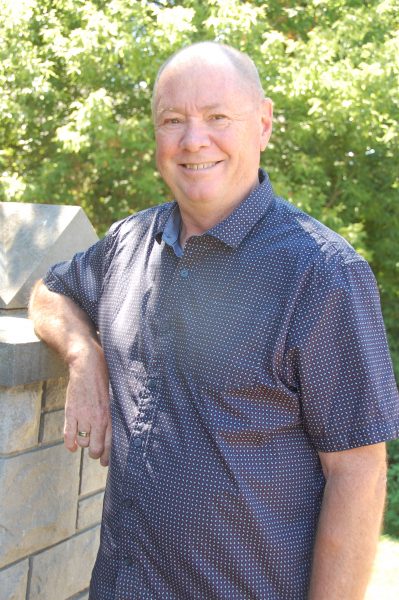Retired NRP Constable Dave Dawson grateful to Hamilton Health Sciences
By Joanne McDonald
NewsNow
Retired NRP Constable Dave Dawson got a second chance at life, a miracle thanks to the medical staff at Hamilton Health Sciences. But there was likely some good karma too, as the well-known and respected officer, through his years of community policing, gave many others a second chance at having a life.
Dawson, 66, suffered a massive stroke May 19, 2019. Time was on his side that day, but just barely, and he shares his personal story to caution others to never wait, never ignore the signs, and never hesitate to call 911 at the first sign that something is wrong.

“Time is brain” and if a clot has caused the stroke, there is about a four-hour window after symptoms start to receive medication that can help reopen the blocked arteries, reduce the severity of a stroke and reverse some stroke effects.
Today, except for some ‘stroke fatigue’ Dawson is back in fine form. It’s a story of success and considering where the clot lodged in his brain, one that doesn’t happen very often.
He had a warning that day, a transient ischemic attack (TIA), a temporary period of symptoms similar to those of a stroke.
“I was home in the morning. Everything went weird, my vision, I was dizzy and I just thought I needed something to eat.”
He went out, came home and by 3 p.m., talking to his mother, his speech was garbled and he couldn’t get the words out.
“My vision was like looking through a kaleidoscope. I broke out in a massive sweat and the room went white.”
He doesn’t recall how long before he fell back on the couch and hit his head, a fall that likely saved his life as it was enough to dislodge the clot that was blocking the flow of blood to his brain.
Regaining consciousness, gasping for air, home alone and unable to see through his fractured vision, he called his wife Brenda.
It was the only number I could see and it took me 10 times to dial the call.”
Arriving within minutes, Brenda called 911. Dawson went by ambulance from his Smithville home to the Dunnville Hospital where chief of emergency Dr. Jeffrey Remington took one look and said, “he’s got to go,” reassuring him help was waiting at the Hamilton General Hospital, regional stroke centre.
Neurologist Dr. Mike Sharma was waiting on the emergency ramp when the ambulance pulled in and he told Dawson,
“I’m going to look after you.”
A CT Scan found a blockage in Dawson’s brain and he was given the ‘clot buster’ drug tPA (tissue plasminogen activator.)
“People often don’t make it to the hospital to use that drug. It must be administered three to four hours following a critical incident,” Dawson said. “Time is key and the longer you wait, the longer your brain is not getting oxygen.”
Dawson refers to the acronym F.A.S.T. – Face drooping; Arm weakness; Speech slurred; and Time to call 911 but warns a stroke may not manifest in a typical way.
“If you have even one symptom call for help. Something is happening,” he noted.
“I should have called for help in the morning but I just carried on with my day as it had cleared up. The stroke happened at 3:05 p.m. By the time I was at the General it was a little after 6 p.m. It was very close.”
Overnight, Dawson’s focus corrected from triple to single vision, he could talk properly and move his arms.
He would later learn the blood clot affected an artery that supported much of his body’s functioning and the likelihood of dying from that kind of stroke was as high as 90 per cent.
Including his wife, there are some key people Dawson wants to thank – they saved his life – Dr. Jeffrey Remington who saved him for time; Dr. Mike Sharma who was waiting on the emergency ramp at the General; Dr. Ben Wyman who said there was enough time to try the clot-busting medication; and his own neurologist Dr. Luchiana Catanese, an “amazing, empathic and kind person” who told him, “you are a very lucky man and you have a second chance at life. Try to make the best of it.”
A second chance indeed and it’s a message he shares with the same positive spirit he brought to his years on the police force.
Dawson who retired in 2015 was a testament to the work of the Niagara Regional Police. Twice awarded as ‘Divisional Officer of the Year’ for 8 District and NRP’s corporate services ‘Officer of the Year’ he had a handle on the local pulse through his focus on community.
“Community policing is about trying to have a presence in the community that is positive.” Whether it was on patrol, liaising with schools, or helping local businesses, it was a comfortable presence. “People realize they can talk to you and share information.”
“Grimsby was my community and every day I tried to do something positive.”
More than a year out from the stroke, Dawson has recovered completely. He has some ‘stroke fatigue’, that is the brain healing from the injury, but looks forward to that being minimized.
He wants the people to know that while doctors work hard to treat their patients, they are impacting entire families.
“What they did for me rippled through my family including my wife, daughter, two sons and grandchildren.”
“They are all thankful for the care I received at the General. It was second to none,” Dawson said. “I will always be grateful to Hamilton Health Sciences – the nurses, the doctors and EMS.”

